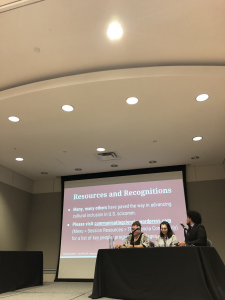By Tere Castro-Saldana
Communicating ciencia II: Engaging the changing faces and voices of mass media was the theme for this highly anticipated session on recognizing the scientific world and its humanity. All three panelists agreed it is time for journalists and writers to accept Latinx audiences as part of the U.S. mainstream, as corporate America has done.
According to the U.S. Census Bureau, currently there are about 48.6 million Spanish speakers in the U.S., and the number is expected to reach some 119 million by 2060. The explosive growth of Spanish speakers was addressed at this year's ScienceWriters2018 conference.
Panelists discussed how they each individually convey science concepts, research, and stories to different Spanish speaking audiences. The panel was organized and moderated by Ben Young Landis, writer-creater, cr8txt, and Becky Oskin, science writer from UC Davis. The three panelists were: Jenny F. de la Hoz, Ph.D., social scientist and facilitator equity consultant at the Center for Equity Inclusion in Oregon; Jose G. Gonzalez, science educator at Latino Outdoors; and Claudia Pineda Tibbs, conservation and science planning and operations manager at the Monterey Bay Aquarium. The session was part of the annual ScienceWriters 2018 meeting, held Oct. 11-16, 2018, in Washington. D.C.Young Landis stated, "As science journalists and science writers we have the duty to reflect the humanity of the readers we serve — and that means understanding how to bridge contexts with the changing faces and voices of the U.S. public."
Collectively, the chosen speakers all have extensive experience in science outreach in their different respective fields. Pineda Tibbs offered pro tips on leveraging social media and other types of technology and explained how this can help you better understand your Latinx audience.
Pineda Tibbs said, "Understanding who your audiences are along with the community — this can be done by activating connections and identifying your cultural and geographical connections so the audience can make those connections and become more engaged and involved in the importance of these media messages that are being disseminated beyond the brick and mortar walls, in my case, of the Monterey Bay Aquarium."
Following Pineda Tibbs, Gonzalez, science educator at Latino Outdoors, straightaway delved into how the Latinx experience is helping to shape the mainstream audience that science journalists are currently writing about.
"With shifting and increasingly diverse demographics, it's incumbent to all communicators to increase their awareness and practice of how their stories are reflective and engaging of these diverse communities. Case in point, Latinx communities," Gonzalez said.Finally the last speaker, de la Hoz, talked about the terms "hybridity" and "transculturation." She said she considers herself a "mestizo," another term relevant to the aforementioned topics.
This session wrapped up with a loud and roaring "SI SE PUEDE!" from the audience at the end. It was also interactive and very engaging because of the learning activities/writing assignments that involved planning and editing stories that have to do with the impacts of plastic pollution in rural communities.






